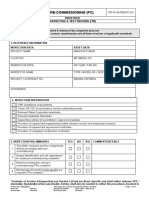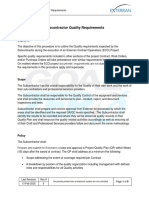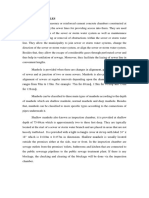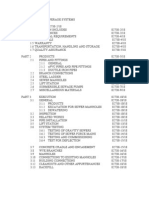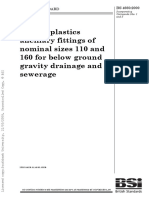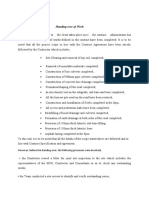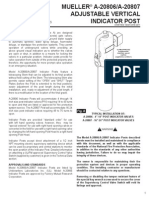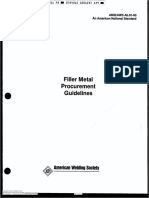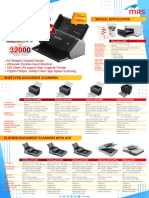05-12 QCS 2014
05-12 QCS 2014
Uploaded by
Raja Ahmed HassanCopyright:
Available Formats
05-12 QCS 2014
05-12 QCS 2014
Uploaded by
Raja Ahmed HassanOriginal Description:
Copyright
Available Formats
Share this document
Did you find this document useful?
Is this content inappropriate?
Copyright:
Available Formats
05-12 QCS 2014
05-12 QCS 2014
Uploaded by
Raja Ahmed HassanCopyright:
Available Formats
QCS 2014
Section 05: Concrete
Part
13: Inspection and Testing of Hardened Concrete
Page 1
INSPECTION AND TESTING OF HARDENED CONCRETE .................................. 2
13.1
13.1.1
13.1.2
13.1.3
13.1.4
13.1.5
13.1.6
GENERAL ............................................................................................................... 2
Scope
2
References
2
Submittals
2
Quality Assurance
3
Non-Compliance of Work
3
General Fieldwork Requirements
4
13.2
13.2.1
13.2.2
13.2.3
13.2.4
CONCRETE CORES ............................................................................................... 4
General
4
Drilling Cores
5
Testing for Strength
6
Assessment of Strength
7
13.3
REINFORCEMENT COVER MEASUREMENTS ..................................................... 7
13.4
13.4.1
13.4.2
13.4.3
13.4.4
ULTRASONIC PULSE MEASUREMENTS .............................................................. 8
General
8
Selection of Test Locations
8
Execution of Tests
8
Estimated In-Situ Cube Strength
9
13.5
RADIOGRAPHY OF CONCRETE ........................................................................... 9
13.6
13.6.1
13.6.2
13.6.3
13.6.4
SURFACE HARDNESS ........................................................................................... 9
General
9
Method of Test
9
Equipment
10
Reporting
10
13.7
13.7.1
13.7.2
CHEMICAL CONTENT .......................................................................................... 10
Sampling
10
Laboratory Testing
11
at
ar
C
on
st
ru
ct
io
Sp
ec
ifi
ca
tio
ns
20
14
13
QCS 2014
Section 05: Concrete
Part
13: Inspection and Testing of Hardened Concrete
Page 2
INSPECTION AND TESTING OF HARDENED CONCRETE
13.1
GENERAL
13.1.1
Scope
This Part of the specification covers the inspection, sampling and testing of hardened
concrete.
Related Section and Parts are as follows:
20
14
13
ns
This Section
Part 6 ............... Property Requirements
References
The following standards are referred to in this part of the specification:
ca
tio
13.1.2
ifi
ACI 214.4R .................Guide for Obtaining Cores and Interpreting Compressive Strength
Results
ec
ACI 318 ERTA ............Building Code Requirements for Structural Concrete (ACI 318-08) and
Commentary
Sp
ASTM C42 ..................Standard Test Method for Obtaining and Testing Drilled Cores and
Sawed Beams of Concrete
ASTM C823 ................Standard Practice for Examination and Sampling of Hardened
Concrete in Constructions
io
BS 1881-124 ..............Testing concrete. Methods for analysis of hardened concrete
ct
BS 1881-204, .............Testing concrete. Recommendations on the use of electromagnetic
covermeters
on
st
ru
BS EN 12350..............Testing fresh concrete
BS EN 12504-1 ..........Testing concrete in structures cored specimens taking, examining and
testing in compression
BS EN 12504-2 ..........Non-destructive testing. Determination of rebound number
ar
C
BS EN 12504-3:2005 Testing concrete in structures. Determination of pull-out force
BS EN 12504-4 ..........Determination of ultrasonic pulse velocity
at
BS EN 13791..............Assessment of in-situ compressive strength in structures and precast
concrete components
GSO ISO 1920-6 ........ Testing of concrete part 6: sampling, preparing and testing of
concrete core .
13.1.3
Submittals
The Contractor shall submit to the Engineer his quality assurance procedures for the
particular parts of the testing work that will be carried out.
The Contractor shall submit for the Engineers approval the curriculum vitae (CV) of the
supervisor proposed for the work.
QCS 2014
Section 05: Concrete
Part
13: Inspection and Testing of Hardened Concrete
Page 3
The Contractor shall through testing agency prepare a factual report that identifies the test
methods used and the test results. The report shall also identify any unusual results or
pertinent information relating to the testing. The report shall be presented in hard and
electronic copies.
For each of the test results the Contractor shall identify the precision or repeatability of the
particular sampling and testing method. This shall be as given from experience of the
particular test by the laboratory or as expected from information in the particular test
standard.
In-place tests will be valid only if the tests have been conducted using properly calibrated
equipment in accordance with recognized standard procedures and acceptable correlation
between test results and concrete compressive strength has been established and is
submitted.
Non-destructive tests shall not be used as the sole basis for accepting or rejecting concrete,
but they may be used to evaluate concrete when the standard-cured strengths fail to meet
the specified strength criteria
13.1.4
Quality Assurance
All field and laboratory testing of concrete shall be carried out by an independent laboratory
approved by the Engineer.
The evaluation of concrete in structure is needed when an existing structure is to be modified
or redesigned; to assess structural adequacy when doubt arises about the compressive
strength in the structure due to defective workmanship, deterioration of concrete due to fire or
other causes;when an assessment of the in-situ concrete strength is needed during
construction; to assess structural adequacy in the case of non-conformity of the compressive
strength obtained from standard test specimens; assessment of conformity of the in-situ
concrete compressive strength when specified in a specification or product standard.
13.1.5
Non-Compliance of Work
If the 28 d works test cubes as defined in clause 6.6 of this Section fail to meet the minimum
criteria, the Engineer shall direct the Contractor to carry out in-place methods to estimate the
concrete strength by non-destructive testing, in-situ drilling of concrete cores or load testing.
ar
C
The parts or elements of the structure made from the defective batch or batches of concrete
as represented by the works test cubes shall be identified by the Engineer and based on this
information the Engineer shall instruct the Contractor on the required number and position of
concrete cores.
at
on
st
ru
ct
io
Sp
ec
ifi
ca
tio
ns
20
14
The Engineer shall review the concrete core test results in conjunction with BS EN 13791 or
ACI 318 whichever is applicable to the structural design.
Based on this assessment the Engineer shall decide the acceptability of the concrete in the
structural element and may either:
(a)
accept the concrete
(b)
instruct that certain remedial works are carried out
(c)
instruct that the element is replaced.
QCS 2014
Section 05: Concrete
Part
13: Inspection and Testing of Hardened Concrete
Page 4
General Fieldwork Requirements
The Contractor shall make all arrangements to provide safe stable access to testing
locations.
When gaining access to testing locations and whilst testing the Contractor shall take care not
to damage the structure or leave it in an untidy or unclean state.
The Contractor shall take precautions to ensure that cooling water from concrete coring/other
operations is discharged such as not to cause a mess or damage the interior or exterior parts
of the structure.
The Contractor shall be responsible for arranging the water supply required for testing.
The Contractor shall arrange for a suitable power supplies. Where testing is being carried out
on an occupied structure a power supply from the building services may not available and the
Contractor shall make arrangements for power supply and extension leads of adequate
length.
The Contractor shall appoint a qualified field supervisor to co-ordinate and manage the field
work. The supervisor shall have not less than five years experience of such work.
Before starting the work, the Engineer with the Contractors supervisor will mark the positions
where field testing is to be carried out. A unique referencing system to identify each sample
or testing location will be adopted, and this will either be referenced on sketch plans or
drawings or by a detailed description used throughout the report to identify test locations.
If testing is being carried out on an occupied structure the Contractor shall co-ordinate with
the owner or operator of the structure to arrange the detailed programme for the works and
gain access to the various parts of the structure.
As soon as laboratory test results are available these shall be submitted by hand or faxed to
the Engineer in draft form. The testing laboratory, or technical bureau assigned by the testing
agency, assigned by the contractor shall provide a technical report providing visual
information and analysing the tests conducted.
10
All core holes, dust sample holes and exploratory investigation areas shall be reinstated with
a proprietary non shrink cementitious repair mortar. The preparation of the hole or area
before reinstatement shall be carried out as per the recommendation of the repair mortar
supplier.
at
ar
C
on
st
ru
ct
io
Sp
ec
ifi
ca
tio
ns
20
14
13.1.6
11
Before filling any core holes, dust sample holes or exploratory investigation areas, the
Contractor shall allow the Engineer time to inspect these areas and obtain written
confirmation from the Engineer before filling.
13.2
CONCRETE CORES
13.2.1
General
The drilling and testing of cores shall be carried out in accordance with BS EN 13791 & BS
EN 12504-1, or GSO ISO 1920-6 or ASTM C42 and ACI 214.4 whichever is applicable to the
structural design.
QCS 2014
Section 05: Concrete
Part
13: Inspection and Testing of Hardened Concrete
Page 5
All of the supplementary information listed by the relevant standards shall be included in the
test report with photographs of the cores.
An assessment of in-situ compressive strength for a particular test region shall be based on
at least 3 cores. Consideration shall be given to any structural implications resulting from
taking cores. The diameter of concrete core shall be at least 100 mm for strength evaluation
unless clear spacing of reinforcement is less than 100 mm and approved by Engineer.
The preferred minimum core diameter is three times the nominal maximum size of the
coarse aggregate, but it shall be at least two times the nominal maximum size of the coarse
aggregate
The Engineer will advise the required number and locations of cores. If the results of the
initial coring are inconclusive, the Engineer may instruct that further cores be taken at certain
locations.
Unless otherwise directed by the Engineer, the Contractor shall ensure that coring does not
cut through any reinforcing steel. The required diameter and depth of concrete cores shall be
as stated in table 13.1
ifi
ec
Table 13.1
ca
tio
ns
20
14
Sp
Minimum Depth of Sampling of Concrete for Testing Purposes (ASTM C823)
Thickness of
Section, m
Types of Construction
0.3 or less
0.3 or greater
entire depth
0.3
0.15 or less
entire depth
0.15 0.6
one half the thickness or
0.15 whichever is greater
0.6 or greater
0.6
ar
C
on
st
ru
ct
io
Slabs, pavements, walls, linings, foundations,
structural elements accessible from one side
only
2
Suspended slabs , walls, conduits,
foundations, structural elements exposed to
the atmosphere at two or more sides;
concrete products
Massive sections
Minimum Depth to Be
Sampled, m
at
1 The requirements of table 13.2.1 may not provide the quantities or dimensions of samples
that are required for all tests, in that case, the necessary additional quantity of concrete in
pieces of appropriate minimum size should be taken at each sampling location.
2 When suspended slabs are cored, it is desirable to leave the lower 25 mm uncored, so as
not to lose the core by its falling from the barrel and to make it easier to patch the core hole.
13.2.2
Drilling Cores
Before beginning coring operations the Contractor shall use a proprietary cover meter to
identify the position of steel reinforcing bars at the testing location.
QCS 2014
Section 05: Concrete
Part
13: Inspection and Testing of Hardened Concrete
Page 6
The Engineer may instruct that the core is taken through the concrete without hitting any
reinforcement or the Engineer may instruct that the core is taken in a position where it is
expected reinforcement will be cut in order to provide a sample of the reinforcement to check
its condition. The locations of all drilling points shall be chosen so that the core contains no
steel parallel to its length.
Before capping, the core shall have a length of at least 95 % of its diameter. Once prepared
for test the core shall have a length at least equal to the diameter and not more than 1.2
times its diameter.
Cores of both 100 mm and 150 mm nominal diameters may be tested provided that the
aggregate size does not exceed 20 mm and 40 mm respectively. Where possible 150 mm
cores should be taken to reduce the variability due to drilling and increase the reliability of the
testing, unless reinforcement is congested and the use of 100 mm cores will reduce the
possibility that the core will contain steel or it is necessary to restrict the sampling to a length
of less than 150 mm.
Where the size of the section precludes the use of 100 mm or 150 mm cores, smaller cores
may be used with the permission of the Engineer.
During drilling operations, a log of observations that may affect the interpretation of core
samples shall be prepared.
If instructed by the Engineer, immediately after the core has been cut and removed and the
structure a carbonation test will be carried out by using a 1 or 2 % solution of phenolphthalein
poured over the cut surface. A photograph shall be taken of the cut core with the
phenolphthalein solution applied to provide a record of the test.
If during the drilling of the core, the core collapses due to weak honeycombed or defective
concrete, the Contractor shall stop the drilling operation and carry out testing at an adjacent
location as advised by the Engineer. If when testing at the second location, the core again
breaks due to honeycombed or defective concrete the freshly cut core shall be retained for
reference and a note made of the condition.
13.2.3
Testing for Strength
The compressive strength of field concrete cores shall be assessed in accordance with BS
EN 13791.
ar
C
The details of the concrete core in accordance with BS EN 13791 shall be recorded and two
photographs on either side of the core taken.
at
on
st
ru
ct
io
Sp
ec
ifi
ca
tio
ns
20
14
Where there is reinforcement in the core, the size and the type of bar shall be noted along
with its cover to the concrete surface, the condition of reinforcing bars shall be noted with a
detailed description of any corrosion of the reinforcement.
Before carrying out the compressive strength testing of the cores, the Contractor shall inform
the Engineer to allow him to witness the testing if required.
Crushed core samples shall be retained by the laboratory and only disposed of after written
approval by the Engineer.
QCS 2014
Section 05: Concrete
Part
13: Inspection and Testing of Hardened Concrete
Page 7
Assessment of Strength
The estimated in-situ strength of the concrete shall be calculated from the core result using
BS EN 13791, ACI 214.4 or ACI 318 whichever is applicable by the structural design.
13.3
REINFORCEMENT COVER MEASUREMENTS
The measurement of cover to reinforcing steel and other metallic items in concrete shall be
carried out in accordance with BS 1881 Part 204 using an electromagnetic device that
estimates the position depth and size of the reinforcement.
The locations for checking cover and the spacing between measurements shall be advised
by the Engineer based on the objective of the investigation. The Contractor shall carry out
calibrations of the electric magnetic device for a particular bar size to allow the bar diameter
to be measured.
While testing, the orientation of steel bars shall be checked.
The electromagnetic device shall incorporate scale or digital display range and shall be
calibrated in accordance with BS 1881 Part 204. When calibrated in this manner the
indicated cover to steel reinforcement shall be accurate to within 5 % or 2 mm which ever
is the greater over the working range given by the manufacturer.
The cover meter shall be used in accordance with the manufacturers instructions and checks
on the zero carried out as specified.
The search head shall be traversed systematically across the concrete, and, where
reinforcement is located, rotated until the maximum disturbance with electromagnetic field is
indicated by the meter.
The cover to the reinforcement shall be noted along with the axis of the reinforcement. The
cover shall also be recorded on the concrete surface with chalk or a suitable non-permanent
marking pen.
Care should be taken to avoid interference from other metallic sources or magnetic material.
The cover meter checks shall be carried out by an operator with five years experience.
on
st
ru
ar
C
The test report on cover shall include the following information:
(a)
date
(b)
time and place of test
(c)
description of the structure or component under investigation
(d)
location of test areas
(e)
make and type of cover meter used
(f)
date of last laboratory calibration of cover meter
(g)
details of site calibration of cover meter, indicated values of cover
(h)
estimated accuracy of quantitative measurements
(i)
configuration of steel reinforcement
at
10
ct
io
Sp
ec
ifi
ca
tio
ns
20
14
13.2.4
QCS 2014
Section 05: Concrete
Part
13: Inspection and Testing of Hardened Concrete
Page 8
ULTRASONIC PULSE MEASUREMENTS
13.4.1
General
The ultrasonic velocity test equipment shall be capable of measuring the transit time of a
pulse vibration through concrete. The length of the pulse part between the transducer
equipment shall be measured, and the pulse velocity calculated.
Ultrasonic pulse velocity testing shall be carried out in accordance with the provisions of BS
EN 12504-4.
Velocities shall be measured at a number of locations around a structure and a velocity
contour of the structure established. A minimum of 40 velocities shall be measured for each
structural element.
13.4.2
Selection of Test Locations
Wherever possible direct transmission arrangements shall be used. The transducers shall be
mounted on a specially formed moulded surface.
The minimum path length shall be 100 mm for concrete in which the nominal maximum size
of aggregate is 20 mm or less and 150 mm for concrete in which the nominal maximum size
of aggregate is between 20 mm and 40 mm. but the path length shall not be longer than
required to detect small regions of bad concrete.
Where concrete contains steel the pulse velocity shall be adjusted in accordance with the
requirement of BS EN 12504-4.
Locations that contain reinforcement directly along or close to the pulse paths shall be
avoided.
Where repositioning is not possible the semi-direct transmission measurement, where
transducers are placed on adjacent faces of the concrete, may be used.
13.4.3
Execution of Tests
Positions chosen for the test locations shall be clearly and accurately marked on the surface
of the concrete.
ar
C
The surface of the concrete shall be shall be cleaned and free from grit and dust. Path
lengths shall be determined to an accuracy of 1 % and a suitable couplant (such as grease)
applied to each of the test points.
at
on
st
ru
ct
io
Sp
ec
ifi
ca
tio
ns
20
14
13.4
Pulse transit times shall be measured by a skilled operator, with a minimum of five years
experience in the use of the equipment.
Pulse velocity measurement equipment shall be in accordance with the requirements of BS
EN 12504-4.
Test results shall be examined and any unusual readings repeated carefully for verification or
amendment.
QCS 2014
Section 05: Concrete
Part
13: Inspection and Testing of Hardened Concrete
Page 9
Estimated In-Situ Cube Strength
A correlation shall be established between the cube crushing strength of the particular mix
used in the structure and the pulse velocity.
Where it is not possible to obtain cubes with the same mix design as the original structure a
combination of coring and ultrasonic pulse velocity testing may be carried out at the direction
of the Engineer, where the cores are used to provide the correlation information required for
the interpretation of the ultrasonic pulse velocity tests.
13.5
RADIOGRAPHY OF CONCRETE
Gamma rays and high energy X-rays, which illustrate by radiographs the concrete defects:
The testing shall be carried out in accordance with the requirements of BS 1881-205 or
equivalent.
13.6
SURFACE HARDNESS
13.6.1
General
Testing of concrete surfaces for hardness using rebound hammers shall be carried out in
accordance with BS EN 12504-2.
The rebound hammer shall only be used for estimation of concrete strength where a specific
correlation is carried out of the concrete from the structure being tested; this shall be from
works test cubes or cores taken from the structure.
The correlation between concrete strength and the rebound number shall be carried out in
accordance with BS EN 12504-2. The precision of the correlation curve between the mean
rebound number and strength shall be stated and this shall be used when reporting any
strength interpretations from surface hardness readings. The use of general manufacturers
correlation or calibration curve for strength shall not be used.
It should be noted that the rebound hammer number only provides information on a surface
layer of approximately 30 mm in depth of the concrete and that this should be quoted in the
test report.
ar
C
The rebound hammer maybe used to establish the uniformity of the finish products or similar
elements in a structure at a constant age, temperature, maturity and moisture condition.
at
on
st
ru
ct
io
Sp
ec
ifi
ca
tio
ns
20
14
13.4.4
13.6.2
Method of Test
A minimum of 12 readings shall be taken to establish a single surface hardness at a
particular location.
The reading shall be on a regular grid between 20 mm to 50 mm spacing over an area not
exceeding 300 mm by 300 mm.
The mean of each set of readings shall be calculated including abnormally high and
abnormally low results unless there is good reason to doubt the validity of a particular
reading.
The coefficient of variation and the standard deviation of the readings shall be reported.
QCS 2014
Section 05: Concrete
Part
13: Inspection and Testing of Hardened Concrete
Page 10
Equipment
The rebound hammer shall be a proprietary type that has been used successfully and
serviced for a minimum of five years.
The hammer shall comprise of a mass propelled by a spring that strikes a plunger in contact
with the surface.
The manufacturers literature shall identify the impact energy and contact area of the plunger
for the hammer.
13.6.4
Reporting
The test report shall affirm that the hardness was determined in accordance with BS EN
12504-2 and shall provide the following information:
20
ns
(b)
description of structure and location of test
(c)
details of concrete
(d)
type of cement
(e)
cement content
(f)
type of aggregate
(g)
type of curing
(h)
age of concrete
(i)
type of compaction of concrete
(j)
forming of surface
(k)
moisture condition of the surface
ifi
ec
Sp
n
io
ct
carbonation state of surface
any suspected movement of the concrete under test
direction of test
ar
C
(n)
on
st
ru
(m)
tio
date time and place of test
ca
(a)
(l)
(o)
any other factors that are considered significant in influencing the hardness readings.
The details of the rebound hammer correlation with strength including the mean, range,
standard deviation and coefficient and variation of each reading shall also be included.
at
14
13.6.3
CHEMICAL CONTENT
13.7.1
Sampling
The Engineer shall instruct the depth increments over which the dust samples are to be
taken, the types of chemical testing to be carried out and the quantity of sample required.
The depth of sample shall not be less than the concrete cover to the reinforcement and at
least 50 mm from the surface of concrete. In presence of reinforcement, the chemical
content shall be tested at least at two levels before and after the depth of reinforcement from
the surface of concrete.
13.7
QCS 2014
Section 05: Concrete
Part
13: Inspection and Testing of Hardened Concrete
Page 11
To provide uniform samples of cement matrix and aggregate, three separate holes shall be
drilled at one location. The diameter of the holes shall be between 12 and 20 mm.
Care shall be taken to discard the material from any render or finish unless this is specifically
required under the investigation.
Care shall be taken to ensure that dust increments are accurately measured by marking the
drill bit.
The dust samples increments shall be carefully transferred to plastic bags and sealed to
avoid contamination. Each sealed bag shall be uniquely identified by the sample identification
and depth increment.
13.7.2
Laboratory Testing
Residual split samples of dust from the field investigation shall be retained until the Engineer
has reviewed the chloride test results. The Engineer may instruct that repeat tests are carried
out on certain samples.
Chloride testing of concrete dust samples shall be by an acid soluble method in accordance
with BS 1881 Part 124. The results shall be reported to two decimal places.
Sulphate testing of concrete dust samples shall be in accordance with BS 1881 Part 124,
using an acid soluble method.
Sp
ec
ifi
ca
tio
ns
20
14
at
ar
C
on
st
ru
ct
io
END OF PART
You might also like
- Dodge Dakota 2001 Service Repair Manual FREE PDF DOWNLOADDocument75 pagesDodge Dakota 2001 Service Repair Manual FREE PDF DOWNLOADsen til50% (2)
- Method Statement - Installation of Sewerage Piles in Live LineDocument9 pagesMethod Statement - Installation of Sewerage Piles in Live LineaceNo ratings yet
- Translated - H3C GB0-191 V7.0Document82 pagesTranslated - H3C GB0-191 V7.0Marcus Amaba100% (3)
- Method Statement Pipe Bursting Manhole To Manhole ACE R2 0414Document17 pagesMethod Statement Pipe Bursting Manhole To Manhole ACE R2 0414Mohd SyazwanNo ratings yet
- Qcs 2014 - Sec21 p10 - Wiring Accessories and General PowerDocument9 pagesQcs 2014 - Sec21 p10 - Wiring Accessories and General PowerchandraNo ratings yet
- Concrete Method StatementDocument14 pagesConcrete Method StatementWufei Chang95% (22)
- Penstock Pre Commissioning ITPDocument4 pagesPenstock Pre Commissioning ITPJoe Mari CapaNo ratings yet
- MOS-SRWSE-20220405-Mechanical Steel & Gavalnized Steel PipeDocument28 pagesMOS-SRWSE-20220405-Mechanical Steel & Gavalnized Steel PipeKhit MakaraNo ratings yet
- 06-1 QCS 2014Document10 pages06-1 QCS 2014Raja Ahmed HassanNo ratings yet
- 01-9 QCS 2014Document8 pages01-9 QCS 2014Raja Ahmed HassanNo ratings yet
- QCS 2014 Section 13 Part 04Document5 pagesQCS 2014 Section 13 Part 04Glexer Dazo CorralesNo ratings yet
- Kahramaa Appendix 11Document41 pagesKahramaa Appendix 11Lepanto SakyodNo ratings yet
- Chiller-Pre Commission ChecksDocument32 pagesChiller-Pre Commission ChecksBibin VijayakumarNo ratings yet
- 05-13 QCS 2014Document15 pages05-13 QCS 2014Raja Ahmed Hassan33% (3)
- 06-1 Road Works General QCS 2014Document6 pages06-1 Road Works General QCS 2014VJ Qatar75% (4)
- 06-6 QCS 2014Document30 pages06-6 QCS 2014Raja Ahmed HassanNo ratings yet
- 05-19 QCS 2014Document8 pages05-19 QCS 2014Raja Ahmed HassanNo ratings yet
- 06-4 QCS 2014Document57 pages06-4 QCS 2014Raja Ahmed Hassan79% (14)
- 05-13 QCS 2014Document15 pages05-13 QCS 2014Raja Ahmed Hassan33% (3)
- Qcs 2010 Part 8.09 Trenchless Pipeline ConstructionDocument10 pagesQcs 2010 Part 8.09 Trenchless Pipeline ConstructionRotsapNayrbNo ratings yet
- Engineering and Construction StandardsDocument102 pagesEngineering and Construction StandardsWei YaoNo ratings yet
- IRRIGATION PPD GUID LINES With AmmementDocument37 pagesIRRIGATION PPD GUID LINES With AmmementIrf NavaneethNo ratings yet
- QCS 2014 - Section 19-Plumbing WorksDocument55 pagesQCS 2014 - Section 19-Plumbing WorksEng. Jamal100% (1)
- Technical SpecificayionDocument40 pagesTechnical SpecificayionDebjit KunduNo ratings yet
- 10.section 4.0 - Sewerage WorksDocument19 pages10.section 4.0 - Sewerage WorksNarain Muthukrishnan100% (1)
- 05-10 QCS 2014Document12 pages05-10 QCS 2014Raja Ahmed HassanNo ratings yet
- Volume-IIIC Functional GuaranteeDocument54 pagesVolume-IIIC Functional GuaranteeVikas DwivediNo ratings yet
- QCS Section 16Document59 pagesQCS Section 16MurugananthamParamasivam67% (3)
- MST-M-0070 Hot Water CalorifiersDocument10 pagesMST-M-0070 Hot Water CalorifiersJERINNo ratings yet
- 01-8 QCS 2014Document12 pages01-8 QCS 2014Raja Ahmed Hassan100% (1)
- Experiment 4Document11 pagesExperiment 4mirza farhanNo ratings yet
- Qcs 2010 Part 8.03 Pipes and Fittings MaterialsDocument23 pagesQcs 2010 Part 8.03 Pipes and Fittings MaterialsRotsapNayrbNo ratings yet
- Attachment 07 - Subcontractor's Quality Management RequirementsDocument6 pagesAttachment 07 - Subcontractor's Quality Management Requirementsum erNo ratings yet
- Testing and Commissioning Procedure: 2017 EDITIONDocument36 pagesTesting and Commissioning Procedure: 2017 EDITIONvin ssNo ratings yet
- QCS-2010 Section 19 Part 2 Water DistributionDocument12 pagesQCS-2010 Section 19 Part 2 Water Distributionbryanpastor106100% (1)
- Sika WaterbarsDocument5 pagesSika WaterbarschaubeyskcNo ratings yet
- 05-18 QCS 2014Document5 pages05-18 QCS 2014Raja Ahmed HassanNo ratings yet
- MS For Pavements RoadsDocument5 pagesMS For Pavements RoadsShan THALANo ratings yet
- Vol. 2 - Technical SpecificationDocument254 pagesVol. 2 - Technical SpecificationpravassNo ratings yet
- Basf Masteremaco 8100 Ap Ms 969522Document2 pagesBasf Masteremaco 8100 Ap Ms 969522aruncg2No ratings yet
- Method Statement For Sewage PipingDocument2 pagesMethod Statement For Sewage PipingVijay MNo ratings yet
- Itp For Plumbing Amp Drainage SystemDocument98 pagesItp For Plumbing Amp Drainage Systemtristan guarinoNo ratings yet
- Electrofusion WeldingDocument4 pagesElectrofusion WeldingRajesh RadeNo ratings yet
- Testing and Commissioning of Fire Fighting System Hose Reel and Sprinkler SystemDocument3 pagesTesting and Commissioning of Fire Fighting System Hose Reel and Sprinkler Systemgaineysk100% (1)
- F3 - Checklist - HDPE Butt Fusion WeldingDocument1 pageF3 - Checklist - HDPE Butt Fusion WeldingQasim Saeed KhanNo ratings yet
- Types of ManholesDocument6 pagesTypes of ManholesEvonYongNo ratings yet
- Asphalt Laying MethodologyDocument4 pagesAsphalt Laying MethodologyRey ZartigaNo ratings yet
- Pudlo CWP TDS1 PDFDocument2 pagesPudlo CWP TDS1 PDFg4goharNo ratings yet
- Sewerage SystemDocument17 pagesSewerage SystemsrivasthuNo ratings yet
- Standard Drawing Guideline - Part 1Document76 pagesStandard Drawing Guideline - Part 1suresh thirumurthyNo ratings yet
- Copy (2) of Dubai Municipality - Swimming Pool SafetyDocument7 pagesCopy (2) of Dubai Municipality - Swimming Pool Safetyabokoraa100% (7)
- Water Resources Management and Sustainability Solutions For AridDocument443 pagesWater Resources Management and Sustainability Solutions For Aridantonio PierceNo ratings yet
- BS 4660 2000 Drainage Ancillary Fittings For Nominal Sizes 110 - 160 Below GradeDocument16 pagesBS 4660 2000 Drainage Ancillary Fittings For Nominal Sizes 110 - 160 Below GradeFenner ElectromechanicalNo ratings yet
- Masteremaco S 433 - TdsDocument3 pagesMasteremaco S 433 - TdsMudassir AliNo ratings yet
- Module - 7 FiltrationDocument33 pagesModule - 7 FiltrationAli AbidNo ratings yet
- SAIC-M-1003Location, Depth of TrenchBoreholes & Elevation For Types I - V Fences InspectionDocument3 pagesSAIC-M-1003Location, Depth of TrenchBoreholes & Elevation For Types I - V Fences InspectionAbuAhmedQuaziNo ratings yet
- Submerssible PumpDocument17 pagesSubmerssible Pumptousif ahmedNo ratings yet
- Shah Zaman - QAQC Mechanical EngineerDocument8 pagesShah Zaman - QAQC Mechanical EngineerShah ZamanNo ratings yet
- However, Before The Handing Over, The Following Processes Were InvolvedDocument2 pagesHowever, Before The Handing Over, The Following Processes Were InvolvedQAZEEM100% (1)
- Lot-Ii Bill of Quantity For Degahbour Water Treatment PlantDocument17 pagesLot-Ii Bill of Quantity For Degahbour Water Treatment Planteyoel ekubemariamNo ratings yet
- QCS 2010 Section 22 Part 5Document15 pagesQCS 2010 Section 22 Part 5Abdelazim Mohamed0% (2)
- Method Statement For On Site Installation of DiffusersDocument2 pagesMethod Statement For On Site Installation of Diffusersamg007No ratings yet
- Site Supervisor PDFDocument2 pagesSite Supervisor PDFVVRAONo ratings yet
- Dosing Pumps Checklist-ElecDocument2 pagesDosing Pumps Checklist-ElecDeshan SingNo ratings yet
- Method Statement - Chasing Work On Block Wall For PVC Conduits PDFDocument2 pagesMethod Statement - Chasing Work On Block Wall For PVC Conduits PDFPrimo MartinezNo ratings yet
- Drlling /blasting Safety Checklist: DrillingDocument6 pagesDrlling /blasting Safety Checklist: DrillingRayees Ahmad100% (1)
- T Proc Notices Notices 040 K Notice Doc 38582 757114055Document19 pagesT Proc Notices Notices 040 K Notice Doc 38582 757114055Hawa KadiriNo ratings yet
- 06-3 QCS 2014Document13 pages06-3 QCS 2014Raja Ahmed Hassan100% (1)
- 02-15 QCS 2014Document17 pages02-15 QCS 2014Raja Ahmed HassanNo ratings yet
- 05-14 QCS 2014Document7 pages05-14 QCS 2014Raja Ahmed HassanNo ratings yet
- 06-8 QCS 2014Document7 pages06-8 QCS 2014Raja Ahmed HassanNo ratings yet
- 05-17 QCS 2014Document8 pages05-17 QCS 2014Raja Ahmed Hassan100% (2)
- 05-15 QCS 2014Document14 pages05-15 QCS 2014Raja Ahmed Hassan100% (2)
- 06-2 QCS 2014Document25 pages06-2 QCS 2014Raja Ahmed Hassan100% (6)
- 05-5 QCS 2014Document31 pages05-5 QCS 2014Raja Ahmed Hassan100% (11)
- 05-18 QCS 2014Document5 pages05-18 QCS 2014Raja Ahmed HassanNo ratings yet
- 05-3 QCS 2014Document5 pages05-3 QCS 2014Raja Ahmed HassanNo ratings yet
- 05-10 QCS 2014Document12 pages05-10 QCS 2014Raja Ahmed HassanNo ratings yet
- 05-8 QCS 2014Document16 pages05-8 QCS 2014Raja Ahmed HassanNo ratings yet
- 05-16 QCS 2014Document10 pages05-16 QCS 2014Raja Ahmed HassanNo ratings yet
- 05-7 QCS 2014Document8 pages05-7 QCS 2014Raja Ahmed HassanNo ratings yet
- 05-9 QCS 2014Document6 pages05-9 QCS 2014Raja Ahmed HassanNo ratings yet
- 04-1 QCS 2014Document7 pages04-1 QCS 2014Raja Ahmed Hassan100% (1)
- 05-6 QCS 2014Document15 pages05-6 QCS 2014Raja Ahmed HassanNo ratings yet
- 05-11 QCS 2014Document8 pages05-11 QCS 2014Raja Ahmed HassanNo ratings yet
- 05-1 QCS 2014Document10 pages05-1 QCS 2014Raja Ahmed HassanNo ratings yet
- 04-4 QCS 2014Document13 pages04-4 QCS 2014Raja Ahmed HassanNo ratings yet
- 05-4 QCS 2014Document5 pages05-4 QCS 2014Raja Ahmed Hassan100% (1)
- 03-5 QCS 2014Document6 pages03-5 QCS 2014Raja Ahmed Hassan0% (1)
- 03-1 QCS 2014Document10 pages03-1 QCS 2014Raja Ahmed HassanNo ratings yet
- Mueller A-20806&a-20807 AdjustableVertical IndicatorPosts Form12111Document8 pagesMueller A-20806&a-20807 AdjustableVertical IndicatorPosts Form12111gbogboiweNo ratings yet
- Specifications: ModelDocument9 pagesSpecifications: ModelGeiler Benitez PiñaNo ratings yet
- VDO Commercal Product CatalogueDocument40 pagesVDO Commercal Product Cataloguejasminbijedic100% (1)
- Anas KhanDocument9 pagesAnas KhanAL Wahid SpareNo ratings yet
- SolutionDocument13 pagesSolutionapi-375485550% (4)
- Liquid Limit TestDocument14 pagesLiquid Limit TestKin Hamzah100% (1)
- Advance Steel Behind The Camera - The Secret To Easy DrawingsDocument13 pagesAdvance Steel Behind The Camera - The Secret To Easy DrawingsrfnNo ratings yet
- True RMS AC + DC Tool Kit DMMDocument2 pagesTrue RMS AC + DC Tool Kit DMMammar_958No ratings yet
- Aws Filler Metal PDFDocument19 pagesAws Filler Metal PDFEngr100% (1)
- JavaScript NotesDocument31 pagesJavaScript NotesabkavitharamNo ratings yet
- Service QualityDocument11 pagesService QualityMang Abdul RohmatNo ratings yet
- STRAMADocument6 pagesSTRAMAClaude PeñaNo ratings yet
- Cat. Emergency LuminaireDocument2 pagesCat. Emergency LuminaireJuan CantuNo ratings yet
- PDN 078927Document164 pagesPDN 078927Cesarsanfelice100% (1)
- GRI Consolidado 2016 PDFDocument443 pagesGRI Consolidado 2016 PDFPablo MalgesiniNo ratings yet
- 7.1.4.9 Lab - Identifying IPv4 AddressesDocument3 pages7.1.4.9 Lab - Identifying IPv4 Addressesرافد البركي50% (2)
- IxD (Interaction Design) Checklist - Myplanet DigitalDocument5 pagesIxD (Interaction Design) Checklist - Myplanet DigitalMartyn13No ratings yet
- As 4032.2-2005 Water Supply - Valves For The Control of Hot Water Supply Temperatures Tempering Valves and enDocument8 pagesAs 4032.2-2005 Water Supply - Valves For The Control of Hot Water Supply Temperatures Tempering Valves and enSAI Global - APACNo ratings yet
- Fh0009en01 FH9 A4Document2 pagesFh0009en01 FH9 A4Marcelo SánchezNo ratings yet
- 938 K PDFDocument36 pages938 K PDFJuanNo ratings yet
- DFACT 45 ResultsDocument7 pagesDFACT 45 ResultsAndriod AppNo ratings yet
- B316 01 PDFDocument24 pagesB316 01 PDFCalidad - TGINo ratings yet
- Trac-nghiem-CSS-P1 KEYDocument7 pagesTrac-nghiem-CSS-P1 KEYNguyễn ThAnh HẢiNo ratings yet
- JK-DZ08-B1A24S ACTIVEBALANCERCAN-ProtocolDocument4 pagesJK-DZ08-B1A24S ACTIVEBALANCERCAN-ProtocolNguyen QuangNo ratings yet
- ?kjsyw VKSJ Leku Fo - QR Lkfèk Kkas DH LQJ (KK: HKKJRH EkudDocument14 pages?kjsyw VKSJ Leku Fo - QR Lkfèk Kkas DH LQJ (KK: HKKJRH Ekudindia.warmexNo ratings yet
- Iso 45001Document9 pagesIso 45001Alita SiswandaniNo ratings yet
- Microtek Family Brochure 2023Document2 pagesMicrotek Family Brochure 2023WORO AGUS NURTIYANTONo ratings yet
- ANSI A13.1 Pipe Color Code ChartDocument3 pagesANSI A13.1 Pipe Color Code Chartm.shehreyar.khanNo ratings yet






